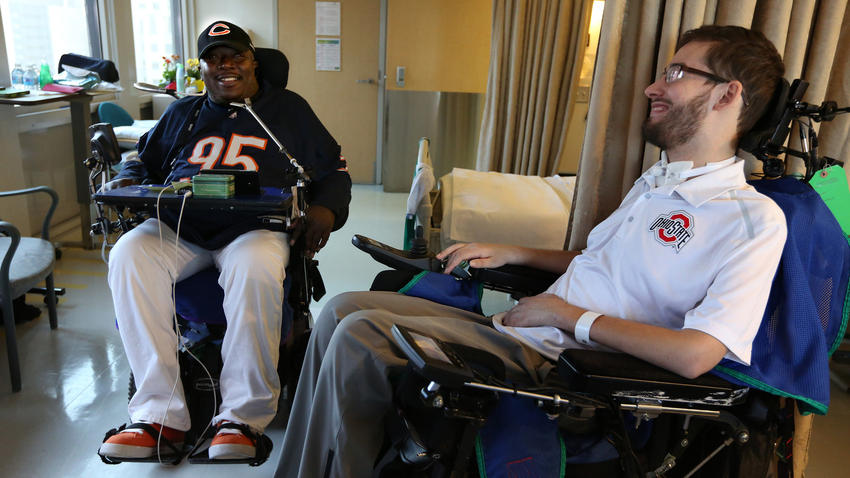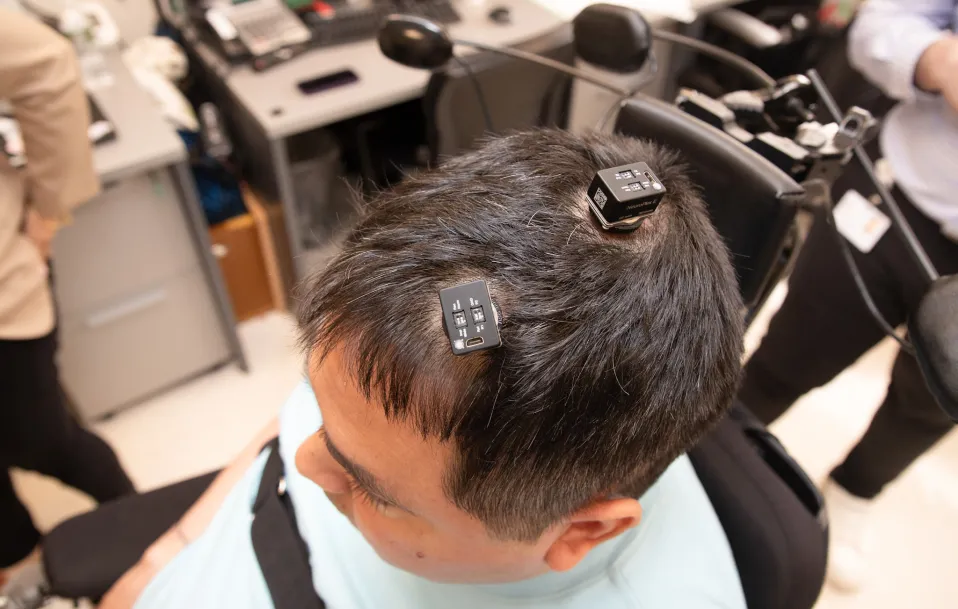Experimental research is aiming to help paralysis victims regain their sense of touch. Miles O’Brien reports on a project run by the Cleveland Functional Electrical Stimulation Center, which is a consortium of the Louis Stokes Cleveland VA Medical Center, MetroHealth Medical Center, Case Western Reserve University, University Hospitals of Cleveland, and the Cleveland Clinic Neurological Institute.
By Miles O’Brien | Listen to Audio Here
William Brangham: Next, we look at the forefront of research to improve the lives of people living with paralysis. Finding a way to bridge the severed connections between their brains and their limbs remains an urgent, but often elusive goal for researchers.As Miles O’Brien reports, they are making steady progress, and they have a good feeling, about restoring some people’s sense of touch. This is the latest in our “Breakthrough” series on the invention and innovation.
Miles O’Brien: Austin Beggin was 22 when his life changed in an instant. A dive into some shallow water left him with a broken neck between the C3 and C4 vertebrae.
Austin Beggin, Study Participant: At that level, you’re talking about breathing, you’re talking about swallowing, you’re talking about pretty much everything as far as how severe of an injury it is.
Miles O’Brien: When he first started living with quadriplegia, he imagined himself getting better.
Austin Beggin: You’re always thinking you’re going to wake up the next day and it’s just going to come back. Three months with really no motor gains kind of set in like this might be more of a long haul.
Miles O’Brien: Now six years since his injury, he is a volunteer participant in a groundbreaking project aimed at changing the long haul for people with paralysis. The big goal is to find a way for them to move their hands, and regain sensations of touch.Austin Beggin is just getting started moving his hand for the first time since his injury.
Austin Beggin: Really is remarkable that these little wires coming out my arms to me are allowing something like this to happen.
Miles O’Brien: What does that feel like?
Austin Beggin: Just the fact that feeling the arm move is the remarkable part of it. I mean, I could do this all day because I have to go up and down, up and down.
Miles O’Brien: It’s a project run by Cleveland’s pioneering Functional Electrical Stimulation Center, part of the Louis Stokes V.A. Medical Center.For 30 years, they have been innovating technology that restores function for people with paralysis.
Bolu Ajiboye, Case Western Reserve University: We are presently trying to understand the underlying mechanisms of the brain that relate to movement and also sensation.Austin, just looking through your spike panel right now and it seems like we have a good number of potentials. So, your brain is working.
Miles O’Brien: Biomedical engineer Bolu Ajiboye is the principal investigator.
Bolu Ajiboye: We would like to be able to design technology that records from the brain, bypasses the spinal cord injury and allows the person to control meaningful movements of their hands, such as positioning their arm in space, moving individual fingers, being able to grasp different objects so that they can perform many activities of daily living that people take for granted every day.
Miles O’Brien: It begins with brain surgery. Austin Beggin’s operation was done by neurosurgeon Jonathan Miller with University Hospitals Cleveland.Dr. Jonathan Miller, Functional & Restorative Neurosurgery Center: So this is the electrode we implant into the brain. As you can see, this is the part that goes in. It’s very small. It actually has a total of six of these that we implant for this particular project going into six different areas of the brain.
Miles O’Brien: But where in the brain? Simply targeting the area that controls the nerves that fire muscles is not enough.
Dr. Jonathan Miller: We’re interested in the areas of the brain that are responsible for motor planning, for not just the actual individual nerves that control the muscles, but also the neurons that are upstream of those that control what it is that the person wants to do.
Miles O’Brien: In another operation, surgeons implanted electrodes to stimulate Beggin’s hand and arm muscles. The surgeries were just the start of a long journey. The team is now busy trying to decipher the myriad of signals from Beggin’s brain measured in micro volts.
Bolu Ajiboye: What we’re interested in is the fact that we’re not just looking at one cell, we’re looking at hundreds of cells. And there’s this —
Miles O’Brien: And this is — this is where you get the pattern?
Bolu Ajiboye: This is where you get the pattern.
Miles O’Brien: So, if he tried right now to move his finger, some of these panels would light up more than others.
Bolu Ajiboye: The firing would change, right. And that change can to the naked eye, maybe be a little bit challenging to detect. So but our algorithms can detect the change not just again in one neuron, but across the population of neurons.
Miles O’Brien: The algorithms are programs that can identify the subtle patterns of brain activity across many neurons linked to specific movements. To improve their accuracy, the team has Beggin play games. He imagines moving his paralyzed arm to match what the animated hand is doing on the screen.
Bolu Ajiboye: There is learning on both sides, actually. So our algorithms get better and better with more information that we have the participant at the same time. There is an opportunity for learning on his end as well.
Miles O’Brien: What they are doing here is unique, but there are several other projects underway aiming to understand the activity of the brain during various functions. Some use brain signals to control robotic arms or enable communication.Austin Beggin’s predecessor in this project was Bill Kochevar, in 2014, he became the first person in the world to be able to use this brain system to control his own limb. He was able to open and close his hand, move his wrist, elbow and shoulder. But he had no sensory feedback. Giving paralyzed people a sense of touch is biomedical engineer Emily Graczyk’s priority.
Emily Graczyk, Case Western Reserve University: Very little is known about the neural language of touch in the human brain. And that’s something that we hope to study here in this project.
Miles O’Brien: Eventually, they will give Austin Beggin a glove with sensors in the fingertips. The hope is they will send sensory information to his brain implants.
Emily Graczyk: Without sensory feedback, you really don’t know how to control the motions that you’re producing. You don’t know how to control the forces you’re exerting on an object or the positioning of your body.
Miles O’Brien: But there is more to touch and motion than that. Something harder to quantify, something Austin Beggin understands profoundly.
Austin Beggin: People say, like, what would you love to do? Just I mean, if I could actively shake someone’s hand, I mean, what would be what? I mean, what. You couldn’t put a price on that to me.
Miles O’Brien: A lot of the technology this team is refining to help paralyzed people came out of a lab nearby, one focused on a disability that is part of my reality.In my next story, I’ll show you how amputees like me are learning how to feel things through their prosthetic limbs.For the PBS NewsHour, I’m Miles O’Brien.



